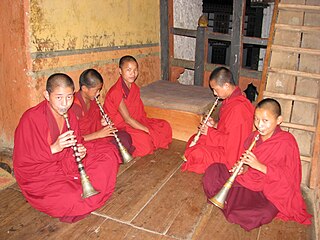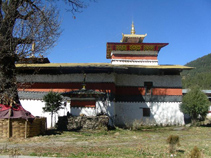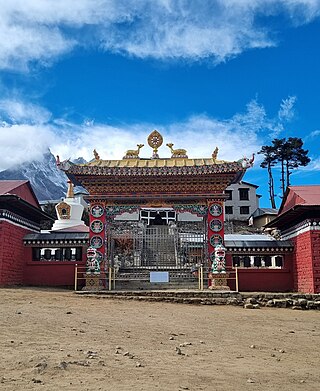
Padmasambhava, also known as Guru Rinpoche and the Lotus Born from Oḍḍiyāna, was a semi-legendary tantric Buddhist Vajra master from India who fully revealed the Vajrayana in Tibet, circa 8th – 9th centuries. He is considered an emanation or Nirmāṇakāya of Shakyamuni Buddha as foretold by the Buddha himself. According to early Tibetan sources including the Testament of Ba, he came to Tibet in the 8th century and designed Samye Monastery, the first Buddhist monastery in Tibet during the reign of King Trisong Detsen. He, the king, and Khenpo Shantarakshita are also responsible for creating the Tibetan Canon through translating all of the Buddha's teachings and their commentaries into the Tibetan language.

The music of Bhutan is an integral part of its culture and plays a leading role in transmitting social values. Traditional Bhutanese music includes a spectrum of subgenres, ranging from folk to religious song and music. Some genres of traditional Bhutanese music intertwine vocals, instrumentation, and theatre and dance, while others are mainly vocal or instrumental. The much older traditional genres are distinguished from modern popular music such as rigsar.

Samye, full name Samye Mighur Lhundrub Tsula Khang and Shrine of Unchanging Spontaneous Presence, is the first Tibetan Buddhist and Nyingma monastery built in Tibet, during the reign of King Trisong Deutsen. Shantarakshita began construction around 763, and Tibetan Vajrayana founder Guru Padmasambhava tamed the local spirits for its completion in 779. The first Tibetan monks were ordained there. Samye was destroyed during the Cultural Revolution then rebuilt after 1988.
Articles related to Bhutan include:

Monlam, also known as The Great Prayer Festival, falls on the 4th to 11th day of the 1st Tibetan month in Tibetan Buddhism.

A tshechu is any of the annual religious Bhutanese festivals held in each district or dzongkhag of Bhutan on the tenth day of a month of the lunar Tibetan calendar. The month depends on the place. Tshechus are religious festivals of the Drukpa Lineage of the Kagyu school of Tibetan Buddhism.

Tamzhing Lhündrup Monastery in Bumthang District in central Bhutan is a Nyingma gompa in Bhutan. Its temple and monastery are remarkable for their direct connection to the Bhutanese tertön and saint, Pema Lingpa (1450-1521) and his tulkus. It is now the seat of Sungtrul Rinpoche, the current speech incarnation of Pema Lingpa.

Hemis Monastery is a Himalayan Buddhist monastery (gompa) of the Drukpa Lineage, in Hemis on the bank of the Indus River, Ladakh, India. Situated 45 km from Leh, it was re-established in 1672 by the Ladakhi king Sengge Namgyal. The annual Hemis festival honouring Padmasambhava is held there in early June.

The dramyin or dranyen is a traditional Himalayan folk music lute with six strings, used primarily as an accompaniment to singing in the Drukpa Buddhist culture and society in Bhutan, as well as in Tibet, Ladakh, Sikkim and Himalayan West Bengal. It is often used in religious festivals of Tibetan Buddhism. The instrument is played by strumming, fingerpicking or plucking. The dramyen, chiwang (fiddle), and lingm (flute) comprise the basic instrumental inventory for traditional Bhutanese folk music.
Dramyin Cham is a form of Cham dance, a masked and costumed dance performed in Tibetan Buddhism ceremonies in Bhutan, Sikkim, Himalayan West Bengal and Tibet. They are a focal point of the Bhutanese festivals of Tsechu. The Dramyin Cham is notable among Cham dances as the lead dancer keeps time with a dramyin - a Himalayan folk music lute, and not a traditional percussion instrument like the cymbals. This is among the few instances of monastic music in the Himalayas where the use of a stringed instrument has been observed.

Paro Taktsang, is a sacred Vajrayana Himalayan Buddhist site located in the cliffside of the upper Paro valley in Bhutan. It is one of thirteen Tiger's Nest caves in historical Tibet in which Padmasambhava practiced and taught Vajrayana.

Sani Monastery, Sa-ni-[tshog], is located next to the village of Sani where the Stod Valley broadens into the central plain of Zanskar in Ladakh, northern India. It is about 6 km to the northwest of the regional centre of Padum, a gentle two-hour walk. Like Dzongkhul Monastery, it belongs to the Drukpa Kargyu school of Tibetan Buddhism, and is the only one of this order in Zanskar which has nuns. It is thought to be the oldest religious site in the whole region of Ladakh and Zanskar.

The Pemayangtse Monastery is a Buddhist monastery in Pemayangtse, near Gyalshing city in Gyalshing district in the northeastern Indian state of Sikkim, located 6 km from Gyalshing city, the district headquarters, 110 km west of Gangtok. Planned, designed and founded by Lama Lhatsun Chempo in 1647, it is one of the oldest and premier monasteries of Sikkim, also the most famous in Sikkim. Originally started as a small Lhakhang, it was subsequently enlarged during the reign of the third Chogyal Chakdor Namgyal and Khenchen Rolpai Dorjee in the year 1705 and consecrated by the third Lhatsun Chenpo Dzogchen Jigme Pawo in the year 1710 C.E. The monastery follows the Nyingma Order of Tibetan Buddhism and controls all other monasteries of that Order in Sikkim. The monks of this monastery are normally chosen from the Bhutias of Sikkim.

Tashiding Monastery is a Buddhist monastery of the Nyingma sect of Tibetan Buddhism in Tashiding, about 27 km from Gyalshing city in Gyalshing district in northeastern Indian state of Sikkim. which is the most sacred and holiest monasteries in Sikkim. It is described as the "Heart of Sikkim/Denzong", citing to its importance of religious sacredness. It is located on top of the hill rising between the Rathong chu and the Rangeet River, 40 kilometres (25 mi) from Gyalshing and 19 kilometres (12 mi) to the south east of Yuksam. The annual festival of Bumchu, meaning ~Holy water~ takes place on the 14th and 15th of the 1st month of Tibetan lunar calendar, often around the months of February and March. The festival is believed to predict the upcoming forecasts and events for Sikkim in the coming year. Undoubtedly, one of the most important and holiest festivals for all the Buddhists in Sikkim and around, it also provides for a perfect platform for all those Non-Buddhists who seek a deeper insight into Buddhism and its religious customs, beliefs and rituals. History of the Festival- Somewhere between 755 and 804 CE in Tibet under the reign of King Trisong Deutsen. It was under his rule that Guru Padmasambhava when invited to Tibet performed a holy sadhana and consecrated the land with water from his SACRED VASE, which was then later concealed as a hidden treasure in his most blessed place, the Tashiding Monastery in Sikkim. Somewhere around 17th century, the vase was again discovered by one of the reincarnations of Padmasambhava and it is since that time, this festival again resumed with all its glory and splendour in the hidden and blessed land of Sikkim/Beyul Demozong. Tashiding is the nearest town to the Tashiding Monastery (Gompa)

Buddhism in the Himachal Pradesh state of India of has been a long-recorded practice. The spread of Buddhism in the region has occurred intermediately throughout its history. Starting in the 3rd century BCE, Buddhism was propagated by the Maurya Empire under the reign of Ashoka. The region would remain an important center for Buddhism under the Kushan Empire and its vassals. Over the centuries the following of Buddhism has greatly fluctuated. Yet by experiencing revivals and migrations, Buddhism continued to be rooted in the region, particularly in the Lahaul, Spiti and Kinnaur valleys.

Tengboche Monastery, also known as Dawa Choling Gompa, in the Tengboche village in Khumjung in the Khumbu region of eastern Nepal is a Tibetan Buddhist monastery of the Sherpa community. Situated at 3,867 metres (12,687 ft), the monastery is the largest gompa in the Khumbu region of Nepal. It was built in 1916 by Lama Gulu with strong links to its mother monastery known as the Rongbuk Monastery in Tibet. In 1934, it was destroyed by an earthquake and was subsequently rebuilt. In 1989, it was destroyed for a second time by a fire and then rebuilt with the help of volunteers and international assistance.

Gompa Drophan Ling of the Polish Buddhist Khordong Association in Darnków in the Table Mountains, is the Buddhist centre of Bhutanese and Tibetan traditions in Poland. This gompa built and decorated according to traditional Bhutanese patterns, is the only building of that kind in Poland, and one of few such buildings in Europe.

According to Tibetan Buddhism the IXth Minling Khenchen Rinpoche is the successive reincarnation of the Minling Kenrab lineage, co-administrator of Mindrolling Monastery and Head Abbot In-Charge of Ngagyur Nyingma College in India, Vajrayana master, scholar, and teacher.

Mani Rimdu is a 19-day festival celebrated by Buddhists in the Everest region of Nepal to mark the founding of Buddhism by Guru Rinpoche Padmasambhava.


















